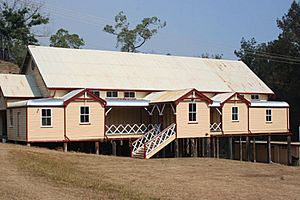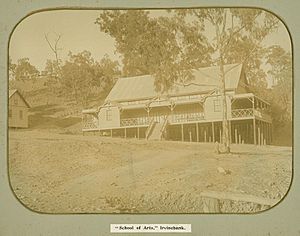Irvinebank School of Arts Hall facts for kids
Quick facts for kids Irvinebank School of Arts Hall |
|
|---|---|

Irvinebank School of Arts Hall, 2009
|
|
| Location | McDonald Street, Irvinebank, Shire of Mareeba, Queensland, Australia |
| Design period | 1900–1914 (early 20th century) |
| Built | 1900 |
| Architectural style(s) | Classicism |
| Official name: Irvinebank School of Arts Hall | |
| Type | state heritage (built) |
| Designated | 29 May 1995 |
| Reference no. | 601619 |
| Significant period | 1900s (historical) 1900s–1910s (fabric) 1900–ongoing (social) 1900s–ongoing (social) |
| Significant components | school of arts |
| Lua error in Module:Location_map at line 420: attempt to index field 'wikibase' (a nil value). | |
The Irvinebank School of Arts Hall is a special old building in Irvinebank, Queensland, Australia. It's like a community center from a long time ago. It was built in 1900 and is now protected as a heritage site. This means it's an important part of Queensland's history.
Contents
A Look Back at the Hall's History
The Irvinebank School of Arts Hall was built around 1900. It was the third building used by the Irvinebank School of Arts Committee. This building shows how much Irvinebank grew when it was a busy mining town.
How Irvinebank Started
In 1880, a lot of tin was found near Herberton. A smart businessman named John Moffat and his company, Glen Smelting Company, quickly took control of the mining in the area. John Moffat came to Queensland from Scotland in 1862. He started his own business, which grew into a big company.
In 1883, while Moffat was away, his business partner, George Young, bought mines in a place called Gibb's Camp. This camp was renamed Irvinebank, after Moffat's hometown in Scotland. A large tin processing plant called the Loudoun Mill opened there in December 1884. Moffat wanted Irvinebank to be a major industrial town. He set up his businesses and his home, Loudoun House, in the town.
What Was a School of Arts?
A School of Arts was like a community learning center. They were popular in many towns across Queensland. The first one in Brisbane opened in 1849. These centers were inspired by similar places in England. They helped people in the community learn new things.
Usually, the local community would start a School of Arts. The government would also give them money to help. These buildings often had a reading room, a library where you could borrow books, and a hall for talks and debates. When the Irvinebank School of Arts opened in 1885, it was very popular. People thought it was smart to spend money on books and newspapers instead of just on the building itself.
Growing with the Town
Irvinebank grew very quickly in the late 1880s and 1890s. Tin mining was doing well, especially after the Vulcan Tin Mine opened in 1889. John Moffat later bought this mine, and it became one of the most successful tin mines.
Because Irvinebank was growing, the old School of Arts buildings became too small. In 1890, the first building was updated. Then, a larger second building was built. This second building was a simple wooden structure.
In 1900, an even bigger building was needed. Plans for the new School of Arts Hall were drawn in September 1900. The new hall was designed with a large main room, which the older buildings didn't have. This meant that traveling shows and plays could now visit the town. In 1912, changes were made to the hall. The entrance was enclosed, and the stage was made bigger. It became one of the largest stages in the north.
Changes Over Time
Irvinebank stayed prosperous until the First World War. After the war, the prices for metals dropped. John Moffat had retired in 1912. The Irvinebank smelters were sold to the Queensland Government in 1918. Since then, the town has slowly become smaller. However, the School of Arts Hall is still used today as a community hall. It remains an important place for activities in Irvinebank.
What the Hall Looks Like
The Irvinebank School of Arts Hall is a one-story wooden building. It stands on an important corner in Irvinebank. Nearby are the Queensland National Bank and John Moffat's house, which are also important historical buildings. The hall is surrounded by old trees, including several fig trees.
The building is raised off the ground on wooden stumps. It has a rectangular shape and a corrugated iron gabled roof. The wooden frame of the building has visible timber studwork. Some parts are covered with horizontal timber boards, protected by verandahs.
The front of the building, facing northeast, looks balanced. It has three projecting sections with pointed roofs (gables). These sections are covered with weatherboards and have simple decorations. They highlight the main entrance in the middle and the two corners. Between these sections is a curved verandah with criss-cross railings. You enter the building through the middle section, going up a straight wooden staircase. High windows above the verandah let in light and air. Round openings on the gables at the front and back also help with light and air.
Inside, there's a large main hall with a stage. There are also semi-enclosed verandah spaces along the two long sides. The hall is completely covered with unpainted red cedar timber boards. These are on the floor, walls, and the partly sloped ceiling. A wooden arch, with decorative carvings, frames the proscenium over the raised stage. The stage and some doors are covered with diagonal timber boards.
Why the Hall is Important
The Irvinebank School of Arts Hall was added to the Queensland Heritage Register on 29 May 1995. This means it's recognized as a very important historical place for several reasons:
- It shows how Queensland's history developed. The hall helps us understand how Irvinebank grew and became successful because of its mining industry. This growth was encouraged by John Moffat, a key person in Queensland's history.
- It has special beauty. The building is in a noticeable spot in Irvinebank. It's part of an important group of buildings that includes the Queensland National Bank and Moffat's house. The Irvinebank School of Arts is a landmark in the town.
- It's important to the community. The Irvinebank School of Arts Hall has been used as a community hall since it was built around 1900. As the only public hall in Irvinebank, it has been the main place for social events in the town.
- It's connected to important people or groups. The building is linked to John Moffat, who is believed to have helped pay for its construction. The hall also shows how a "School of Arts" worked, which was a common type of community center in many Queensland towns in the 1800s.


